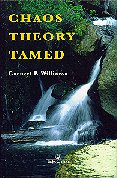With a subject that has caught the public's imagination, it is easy to find mathematics-free glossy coffee table and popular books; in a subject that is deep, powerful and useful it there are many post-graduate level research papers. But while a subject is still relatively new and immature, it is difficult to find those intermediate level texts that allow deeper understanding without requiring the reader to be a full time specialist in the area. This book goes some way to filling that gap.
Williams explains many of the concepts of chaos, with a lot of explanation to help build intuition about why the definitions work, and a lot of discussion about how to calculate the quantities from real data, and how much data is needed to get meaningful answers. Very little mathematical sophistication is assumed; nearly half to book is given over to explaining background material such as vectors, probability, and Fourier analysis -- again emphasising how to use these techniques, and what happens when you use them on real, noisy, data. The detailed explanations of how to calculate a result (not just a bald presentation of a formula) should be a great help those whose algebra is a bit rusty -- and is easily skipped by the rest.
I found the emphasis on real world data refreshing, exhibiting the messy concerns of a field scientist, rather than the mathematical cleanliness of a theoretician. But I must admit I was left with a bit of a "so what?" feeling. So, I might now feel confident about calculating a Lyapunov exponent -- but what do I do with it then? What kinds of problems can it help me with? Maybe what is needed is a companion volume -- having successfully tamed the beast, we now need to set it to work.
